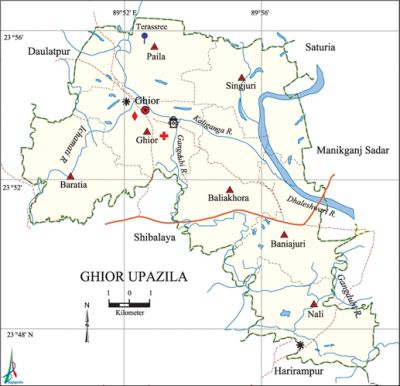Ghior Upazila
Ghior Upazila (manikganj district) area 148.92 sq km, located in between 23°47' and 23°57' north latitudes and in between 89°49' and 89°59' east longitudes. It is bounded by daulatpur (manikganj) upazila on the north, shibalaya and harirampur upazilas on the south, manikganj sadar and saturia upazilas on the east, Shibalaya and Daulatpur (Manikganj) upazilas on the west.
Population Total 146292; male 70945, female 75347; Muslim 127381, Hindu 18901, Christian 6 and others 4.
Water bodies Main rivers: dhaleshwari, Kaliganga, ichamati, Gangdubi; Bairagir Beel is notable.
Administration Ghior Thana was formed in 1919 and it was turned into an upazila in 1983.
| Upazila | ||||||||
| Municipality | Union | Mouza | Village | Population | Density (per sq km) | Literacy rate (%) | ||
| Urban | Rural | Urban | Rural | |||||
| - | 7 | 169 | 187 | 6635 | 139657 | 982 | 69.5 | 53.8 |
| Upazila Town | ||||||||
|
Area (sq km) |
Mouza |
Population |
Density (per sq km) |
Literacy rate (%) | ||||
| 4.25 | 2 | 6635 | 1561 | 69.5 | ||||
| Union | ||||
| Name of union and GO code | Area (acre) | Population | Literacy rate (%) | |
| Male | Female | |||
| Ghior 47 | 5015 | 12057 | 12287 | 60.4 |
| Nali 59 | 4877 | 7013 | 7662 | 57.3 |
| Paila 71 | 5841 | 9666 | 10144 | 48.1 |
| Baratia 35 | 5137 | 10261 | 11138 | 50.0 |
| Baniajuri 23 | 4844 | 12358 | 13449 | 60.5 |
| Baliakhora 11 | 5536 | 10274 | 10929 | 59.9 |
| Singjuri 83 | 5549 | 9316 | 9738 | 42.0 |
Source Bangladesh Population Census 2011, Bangladesh Bureau of Statistics.
Archaeological heritage and relics Neelkuthi at village Sreebari Baratia, Bauddha-vihara at Panchthubi.'

War of Liberation During the war of liberation in 1971 43 villagers were killed by the Pak Army on 22 November at village Terassree. Freedom fighters carried out attacks on the local police station two times during the period of the War of Liberation and captured huge amount of arms and ammunitions. They also had encounters with Pak army and their collaborators at few other places. A memorial plate and a memorial monument had been established in the upazila.
For details: see ঘিওর উপজেলা, বাংলাদেশ মুক্তিযুদ্ধ জ্ঞানকোষ (Encyclopedia of Bangladesh War of Liberation), বাংলাদেশ এশিয়াটিক সোসাইটি, ঢাকা ২০২০, খণ্ড ৩।
Religious institutions Mosque 118, temple 64, tomb 1.
Literacy rate and educational institutions Average literacy 54.5%; male 58.4%, female 50.8%. Noted educational institutions: Ghior DN High School (1929), Terassree KN High School (1922), Baniajuri High School (1945), Singjuri High School (1966).
Cultural organisations Library 2, club 83, cinema hall 1, theatre group 2, jatra party 1.
Main sources of income Agriculture 54.03%, non-agricultural labourer 3.01%, industry 1.86%, commerce 16.24%, transport and communication 3.84%, service 11.94%, construction 2.16%, religious service 0.34%, rent and remittance 1.04% and others 5.54%.
Ownership of agricultural land Landowner 59.06%, landless 40.94%; agricultural landowner: urban 70.17% and rural 58.54%.
Main crops Paddy, wheat, mustard, potato, onion, garlic, chilli, vegetables.
Extinct or nearly extinct crops Kaun, sesame, linseed, paira (millet), indigo.
Main fruits Lemon, mango, jackfruit, papaya, banana, guava, kamranga.
Fisheries, dairies and poultries Dairy 15, poultry 250.
Communication facilities Pucca road 52 km, semi-pucca road 12 km, mud road 220 km; bridge 47, culvert 42.
Extinct or nearly extinct traditional transport Palanquin, bullock and buffalo cart.
Noted manufactories Flour mill, particle board, bidi factory.
Cottage industries Goldsmith, blacksmith, potteries, weaving, bamboo and cane work, wood work, tailoring.
Hats, bazars and fairs Hats and bazars are 24, fairs 11, most noted of which are Ghior Hat, Ghior Rath Mela, Dol Mela at Narchi, Nimai Chand Mela at Pukuria.
Main exports Onion, garlic, chili, vegetables.
Access to electricity All the unions of the upazila are under rural electrification net-work. However 53.5% of the dwelling households have access to electricity.
Sources of drinking water Tube-well 97.2%, tap 0.3% and others 2.5%.
Sanitation 67.9% of dwelling households of the upazila use sanitary latrines and 29.8% of dwelling households use non-sanitary latrines; 2.3% of households do not have latrine facilities.
Health centres Upazila health complex 1, satellite clinic 8, family planning centre 6, clinic 4, veterinary hospital 1.
NGO activities Operationally important NGOs are brac, proshika, asa. [Madhusudan Saha]
References Bangladesh Population Census 2001 and 2011, Bangladesh Bureau of Statistics; Cultural survey report of Ghior Upazila 2007.
